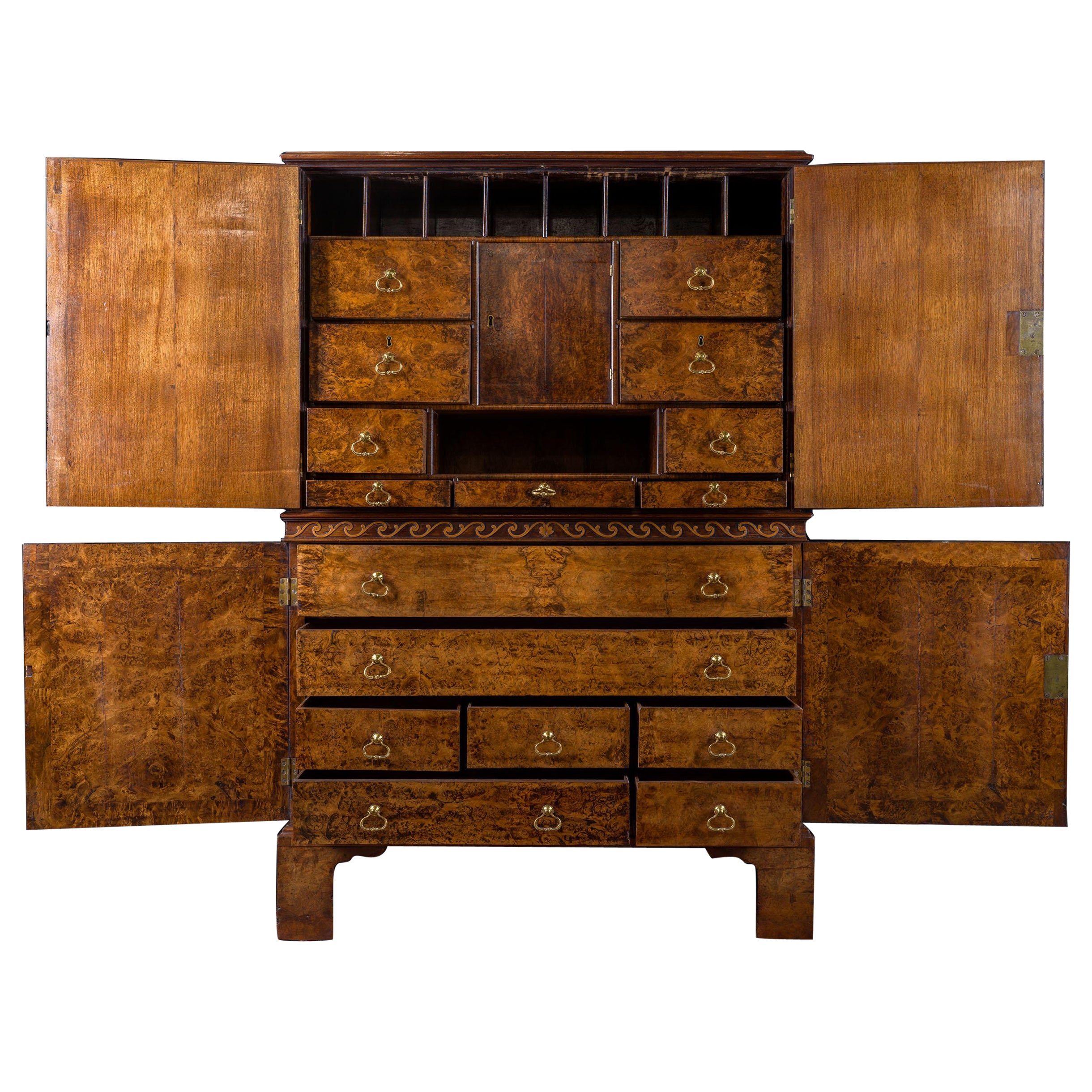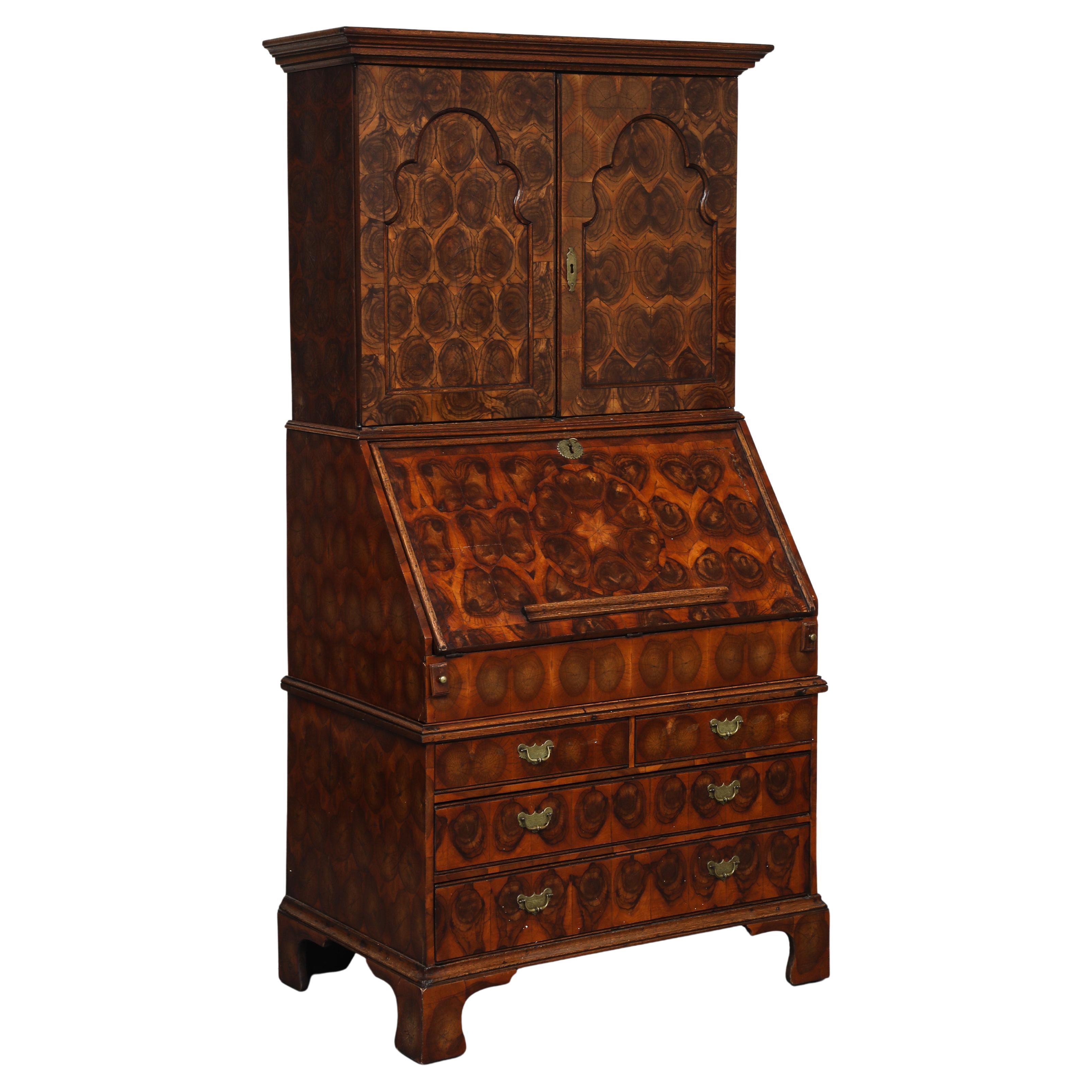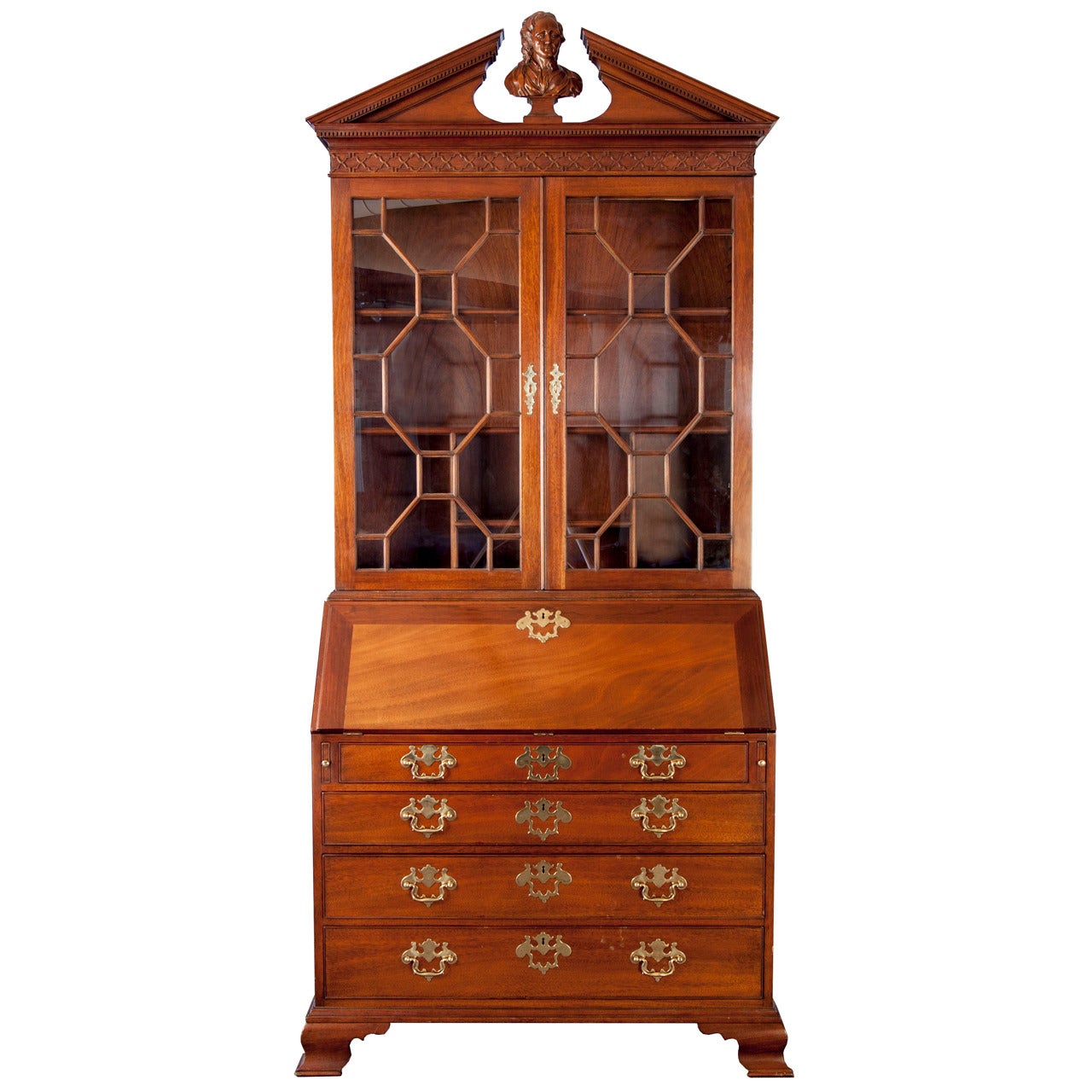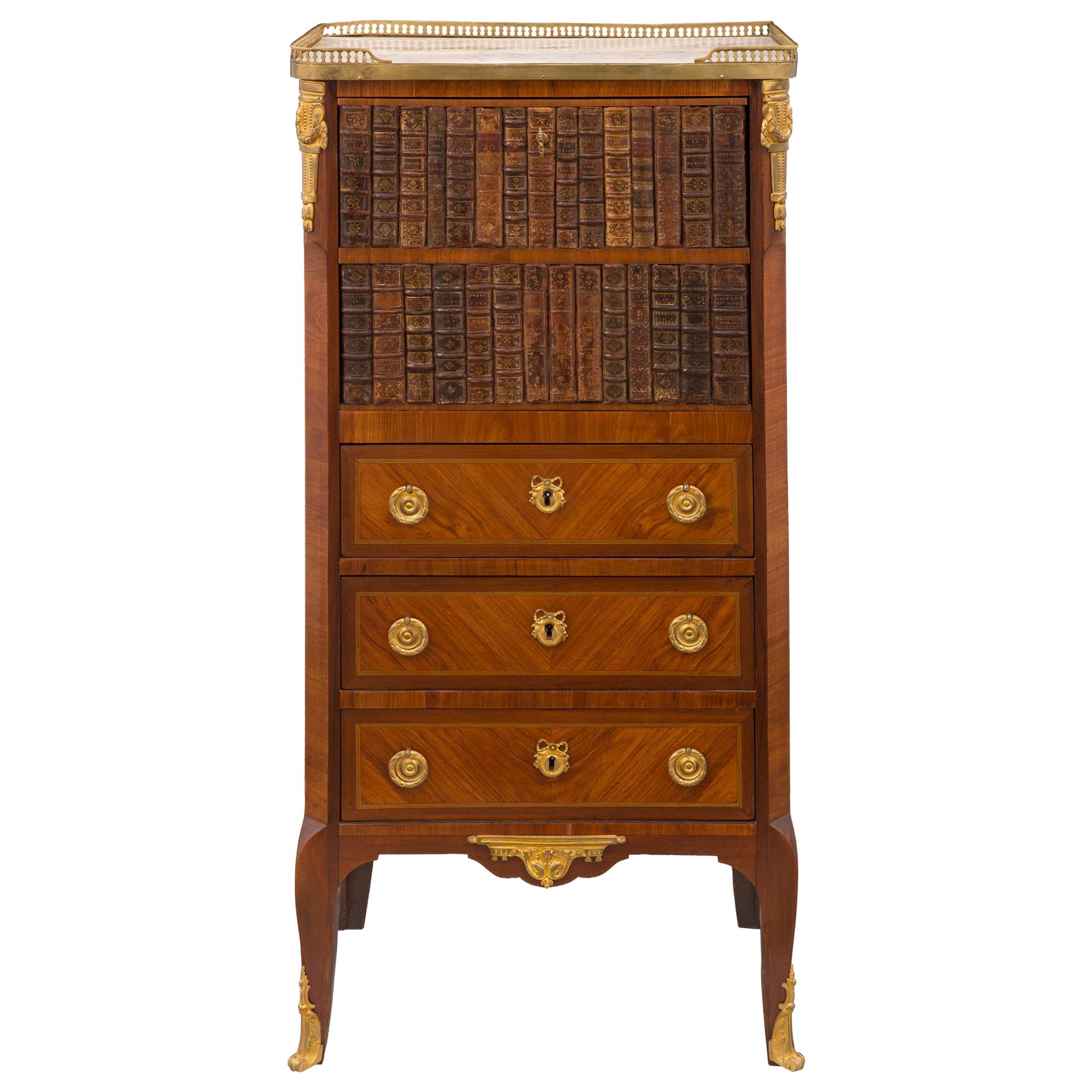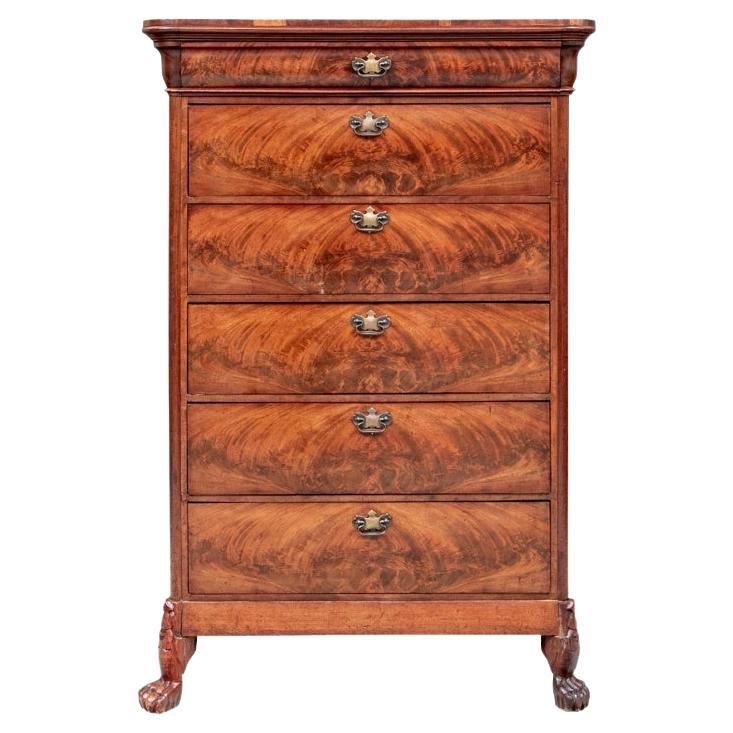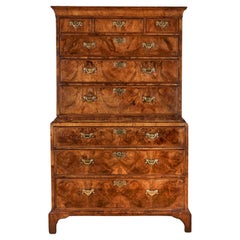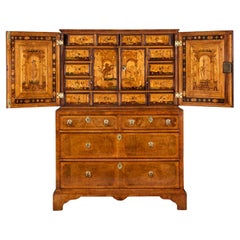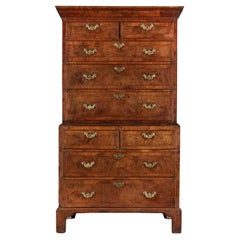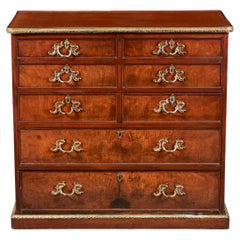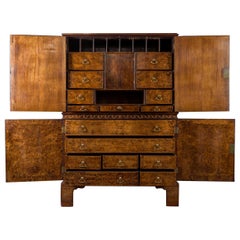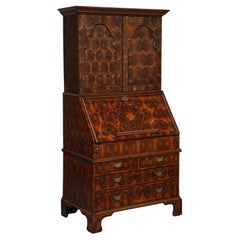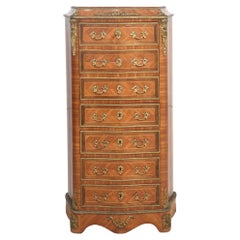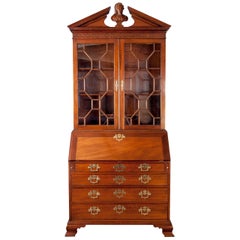Items Similar to A George I Mulberry Secretaire Bureau Attributed to Coxed & Woster
Want more images or videos?
Request additional images or videos from the seller
1 of 10
A George I Mulberry Secretaire Bureau Attributed to Coxed & Woster
$72,037.45
£53,000
€62,052.41
CA$100,904.51
A$110,727.61
CHF 57,330.28
MX$1,325,499.89
NOK 719,265.99
SEK 676,690.84
DKK 463,503.36
About the Item
England, circa 1710.
An important George I secretaire bureau in finely veneered ‘mulberry wood’ attributed to Coxed & Woster, with satinwood crossbanding, rosewood mouldings and pewter string inlay. The top with parliament hinged doors and oriental brass mounts, opening to reveal an arrangement of ten drawers with original engraved brass handles, the bottom with three drawers below a hinged secretaire desk lined with brown leather and further shelves, all terminated in four bun feet.
Height 184.00 centimetres.
Width 98.00 centimetres.
Depth 52.00 centimetres.
Attributed to London cabinetmakers Coxed & Woster, based in the White Swan workshop on the south side of St. Paul’s Churchyard from circa 1690-1736. Similarities can be found in this bureau to a group of examples bearing the trade paper label for G. Coxed and T. Woster.
The earliest examples are veneered with what is commonly termed ‘mulberry’, a timber that originally was thought to have come from the mulberry bush or tree but has been recently identified as stained maple, burr elm or sycamore to give a dramatic tortoiseshell effect.
In Stalker and Parker's treatise on japanning, a section outlines the technique of using nitric acid or aqua fortis, metal filings and lampblack mixes with linseed oil to produce ‘mulberry wood’. If actual mulberry wood is ebonized to reinforce its markings it does not take the staining effectively whereas with elm, maple and sycamore have more porous parts in the grain which retains the dark streaks to produce this dramatic tortoiseshell-like appearance.
It is believed that very few British cabinet makers knew how to create this effect and that the staining process was hotly guarded, with Coxed & Woster being prominent exponents. The popularity of these veneers in the 1690-1730 period is thought to stem from the use of tortoiseshell in the fashionable and influential designs produced by famed French cabinet makers Pierre Golle and André Charles Boulle. (For more information on the use of aqua fortis see A. Bowett, Early Georgian Furniture 1715-1740, Antique Collector's Club, 2009, p.311.)
Further to the expertly stained ‘mulberry wood’ on this bureau, there is kingwood crossbanding, rosewood mouldings and pewter inlay, all further details which recur in Coxed and Woster pieces and reinforce this attribution. (See R.Edwards & M.Jourdain, Georgian Cabinet-Makers, p.91-92, plates 212-213.)
The use of metal line inlay was almost certainly due to the influence of Gerrit Jensen who introduced such Continental techniques into England in the late 17th century. The bureau also features distinctly Japanese corner hinges which are clearly influenced by the lacquer cabinets-on-stands that came to Europe via the Dutch East India Company and became prized collector’s pieces.
These hinges contrast with the European practice of concealed hinges to the interior of cabinet doors, and often make an appearance on English pieces that have been ‘japanned’ to imitate lacquer (as on the piece pictured as plates 3:82 and 3:83 in Adam Bowett’s Early Georgian Furniture 1715-1740).
When they do appear on cabinets of more English form, they tend to be attributed to Coxed & Woster on account of the labelled examples figs. 241 and 242 as pictured in Christopher Gilbert’s Pictorial Dictionary of Marked London Furniture 1700-1840. For instance, a wood-veneered example with these Japanese-style hinges was offered at Christie’s New York, 14th October 2004, lot 41.
These distinctive hinges also often overlap with the ‘mulberry’ staining to the veneers and pewter stringing, both seen on the above-mentioned examples.
Adam Bowett & Laurie Lindey, Literature: Furniture History, The Journal of The Furniture History Society, Vol. XXXIX, 2013 ‘Labelled furniture from the White Swan workshop’, pp 71-98.
Adam Bowett, English Furniture 1660 - 1714 From Charles II to Queen Anne, pp 224-226.
Adam Bowett, Early Georgian Furniture 1715-1740, Woodbridge, 2009, pp.138-139, pl.3:82 and 3:83.
R. Edwards & M. Jourdain, Georgian Cabinet-Makers, p.91-92.
Christopher Gilbert, Pictorial Dictionary of Marked London Furniture 1700-1840, Leeds, 1996, pp.156-157, figs. 241 and 242.
- Attributed to:Coxed and Woster (Cabinetmaker)
- Dimensions:Height: 72.45 in (184 cm)Width: 38.59 in (98 cm)Depth: 20.48 in (52 cm)
- Style:George I (Of the Period)
- Materials and Techniques:
- Place of Origin:
- Period:
- Date of Manufacture:circa 1710
- Condition:Wear consistent with age and use.
- Seller Location:London, GB
- Reference Number:1stDibs: LU957346538632
About the Seller
4.6
Gold Seller
Premium sellers maintaining a 4.3+ rating and 24-hour response times
1stDibs seller since 2012
156 sales on 1stDibs
Typical response time: 8 hours
Associations
The British Antique Dealers' Association
- ShippingRetrieving quote...Shipping from: London, United Kingdom
- Return Policy
Authenticity Guarantee
In the unlikely event there’s an issue with an item’s authenticity, contact us within 1 year for a full refund. DetailsMoney-Back Guarantee
If your item is not as described, is damaged in transit, or does not arrive, contact us within 7 days for a full refund. Details24-Hour Cancellation
You have a 24-hour grace period in which to reconsider your purchase, with no questions asked.Vetted Professional Sellers
Our world-class sellers must adhere to strict standards for service and quality, maintaining the integrity of our listings.Price-Match Guarantee
If you find that a seller listed the same item for a lower price elsewhere, we’ll match it.Trusted Global Delivery
Our best-in-class carrier network provides specialized shipping options worldwide, including custom delivery.More From This Seller
View AllA George II Walnut Chest on Chest
Located in London, GB
England, circa 1740.
A fine George II walnut chest on chest, with original brass escutcheons and handles, the top with concave moulded cornice above three short and three long gradu...
Category
Antique Mid-18th Century English George II Commodes and Chests of Drawers
Materials
Walnut
A North European 18th Century Walnut Marquetry Cabinet on Chest.
Located in London, GB
Northern Europe, circa 1720
An early eighteenth century cabinet on chest in figured walnut, the top with crossbanded double doors revealing an interior fitted with eleven drawers su...
Category
Antique Early 18th Century German Cabinets
Materials
Walnut
A Walnut Chest on Chest
Located in London, GB
A fine George II walnut chest on chest, with original brass escutcheons and handles, the top with concave moulded cornice.
Category
Antique Mid-18th Century English George II Commodes and Chests of Drawers
Materials
Brass
$14,793
Fine 19th Century Mahogany Chest of Drawers
Located in London, GB
A very fine early nineteenth century mahogany chest of drawers, the top four drawers dummy with open lid, with three drawers below, the handles with fine Rococo brasswork, lined thro...
Category
Antique Early 19th Century Commodes and Chests of Drawers
Materials
Mahogany
Early 19th Century Empire Commode
Located in London, GB
France, c. 1820
An early 19th century Empire mahogany commode with finely chased ormolu mounts, retaining the original marble top.
Height 88.50cm
Width 130.00cm
Depth 57.00cm
Category
Antique Early 19th Century French Empire Commodes and Chests of Drawers
Materials
Marble
A Rare Mid 19th Century Anglo Chinese Amboyna Bookcase
Located in London, GB
Anglo Chinese, circa 1860
A rare mid nineteenth century Anglo Chinese campaign amboyna and ebonised bookcase with glazed upper section, the doors revealing three shelves and two dra...
Category
Antique Mid-19th Century Chinese Campaign Bookcases
Materials
Amboyna
You May Also Like
George I Mulberry Veneered Cabinet
Located in London, GB
An unusual George I 'mulberry' cabinet in the manner of Coxed and Woster. The cross banded and veneered walnut doors reveal a fine fitted interior which is al...
Category
Antique Early 18th Century European George I Cabinets
Materials
Walnut
20th Century English Secretaire with Oyster Veneer
Located in Chicago, IL
20th Century English secretaire is a classic example of fine craftsmanship. It features a distinctive oyster veneer pattern and includes a secret compartment within the desk. Desk is...
Category
20th Century English Secretaires
Materials
Wood
19th century secretaire abattant
Located in Cheshire, GB
A French secretaire a’ abbattant, in the Louis XVI taste, the well-figured top, above conforming serpentine front over a fall front secretaire, enclosing drawers and shelf with a gre...
Category
Antique Late 19th Century French Commodes and Chests of Drawers
Materials
Wood
National Trust John Locke Secretaire
Located in Asheville, NC
This very rare Kindel reproduction is part of The National for Historic Preservation Collection, The Cliveden desk and bookcase is truly a masterpiece. An outstanding example of the Rococo style, the Cliveden desk and bookcase is English, circa 1750, and part of the collection on display at Cliveden Mansion in Germantown, PA. Kindel Furniture Company was selected as licensee to the National Trust to make a faithful reproduction of this secretary desk. This reproduction has all of the outstanding qualities of the original. Made of select mahogany, the bookcase has a "broken molded pediment" with decorative frieze and a superb hand-carved bust of John Locke...
Category
Mid-20th Century American Rococo Secretaires
French Transitional 19th Century Ladies Writing Secretaire
Located in West Palm Beach, FL
A charming French 19th century Transitional style tulipwood, ormolu, and white Carrara marble secretary desk. The secretary is raised by fine cabriole legs with elegant foliate ormol...
Category
Antique 19th Century French Secretaires
Materials
Carrara Marble, Ormolu
Antique Burled Secretaire a Abattant for Restoration
Located in Bridgeport, CT
A tall cabinet with carved cavetto cornice, over a slim curved frieze drawer and one upper and two lower long drawers. The middle faux drawers drop down to the secretary. The fitted interior with drawers, white porcelain pulls and a center compartment with door housing an inkstand with two glass bottles with silver-plate tops. With patinated brass bat...
Category
Antique 19th Century Regency Secretaires
Materials
Brass
